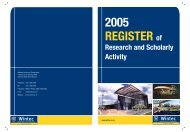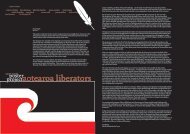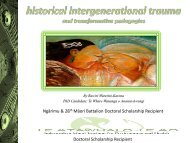Determination of EDTA in Dairy Wastewater and Adjacent Surface ...
Determination of EDTA in Dairy Wastewater and Adjacent Surface ...
Determination of EDTA in Dairy Wastewater and Adjacent Surface ...
You also want an ePaper? Increase the reach of your titles
YUMPU automatically turns print PDFs into web optimized ePapers that Google loves.
PROCEEDINGS OF WORLD ACADEMY OF SCIENCE, ENGINEERING AND TECHNOLOGY VOLUME 34 OCTOBER 2008 ISSN 2070-3740<br />
(Merck) <strong>in</strong> 1L <strong>of</strong> pH = 3.3 buffer solution. A stock <strong>EDTA</strong><br />
st<strong>and</strong>ard solution (0.1 g L -1 <strong>EDTA</strong>) was prepared by dissolv<strong>in</strong>g<br />
0.1462 g ethylenediam<strong>in</strong>etetraacetic acid iron sodium salt (MW<br />
= 421.10 g mol -1 ) (Merck) <strong>in</strong> 1L <strong>of</strong> water, <strong>and</strong> stored <strong>in</strong> the<br />
refrigerator wrapped <strong>in</strong> t<strong>in</strong> foil. St<strong>and</strong>ard solutions, rang<strong>in</strong>g<br />
from 0–750 µg L -1 <strong>EDTA</strong> for calibration, were prepared daily<br />
from the stock solution. A Fe 3+ solution (0.1941g L -1 or 3.47<br />
mM) was prepared by dissolv<strong>in</strong>g 2.4203 g FeCl 3· 6H 2 O<br />
(Merck) <strong>and</strong> 0.144mL HCl (37% Merck) <strong>in</strong> 500 mL water. A<br />
nitrate solution (1 g L -1 ) was prepared by dissolv<strong>in</strong>g 0.4077 g <strong>of</strong><br />
KNO3 (Seelze–Hannover) <strong>in</strong> 250 mL water as a stock solution<br />
for further dilution. Calcium (0.1 g L -1 ) <strong>and</strong> magnesium (0.1 g<br />
L -1 ) ion solutions were prepared by dissolv<strong>in</strong>g 0.2732g <strong>of</strong><br />
CaCl2· 6H2O (BDH) <strong>and</strong> 0.1046 g <strong>of</strong> MgCl 2· 6H 2 O (BDH) <strong>in</strong><br />
500 mL water respectively for further dilution.<br />
Sample Collection<br />
<strong>Dairy</strong> wastewaters were 24–hour composite<br />
flow-proportional samples <strong>in</strong>clud<strong>in</strong>g plant process<strong>in</strong>g<br />
wastewater, wastewater treatment process<strong>in</strong>g sample <strong>and</strong> dairy<br />
effluents, which were collected at varied sites <strong>in</strong> August,<br />
October <strong>and</strong> December, 2007.<br />
<strong>Surface</strong> water samples were collected at 2500 m (site 1) <strong>and</strong><br />
10 m (site 2) upstream <strong>and</strong> 10 m (site 3) <strong>and</strong> 60 m (site 4)<br />
downstream <strong>of</strong> dairy effluent discharges <strong>in</strong> the adjacent river <strong>in</strong><br />
August, October, 2007. Sampl<strong>in</strong>g sites are shown <strong>in</strong> Fig. 1. The<br />
river was approximately 6-8 m wide <strong>and</strong> 1-2 m deep. <strong>Surface</strong><br />
water samples <strong>in</strong>cluded a morn<strong>in</strong>g <strong>and</strong> an afternoon sample<br />
which were comb<strong>in</strong>ed by two different samples from the<br />
morn<strong>in</strong>g <strong>and</strong> afternoon, respectively.<br />
All samples were collected <strong>in</strong> opaque PE bottles to avoid<br />
photolysis <strong>of</strong> the Fe(III)<strong>EDTA</strong> <strong>and</strong> refrigerated at 4 0 C till<br />
analyz<strong>in</strong>g.<br />
Stream 2<br />
River flow<br />
Stream 1<br />
Fig 1 Sampl<strong>in</strong>g sites <strong>of</strong> surface waters upstream <strong>and</strong> downstream <strong>of</strong> the<br />
dairy effluent discharge<br />
Sample Pre-Treatment<br />
Sample pre-treatment <strong>of</strong> dairy effluents <strong>in</strong>volved tak<strong>in</strong>g 1–5<br />
mL aliquots, add<strong>in</strong>g appropriate Fe 3+ solution to the test tube<br />
depend<strong>in</strong>g the predicted <strong>EDTA</strong> concentration, leav<strong>in</strong>g<br />
overnight <strong>in</strong> the dark to allow complex<strong>in</strong>g <strong>of</strong> Fe(III)<strong>EDTA</strong>,<br />
filter<strong>in</strong>g through 0.45 µm cellulose nitrate filters<br />
(Phenomenex), <strong>and</strong> <strong>in</strong>ject<strong>in</strong>g 50 µL sample <strong>in</strong>to the HPLC<br />
system at ambient temperature.<br />
Sample pre-treatment <strong>of</strong> surface water <strong>in</strong>volved heat<strong>in</strong>g 10<br />
mL water sample to dryness at 90 0 C oven, add<strong>in</strong>g 1.5 mL<br />
mobile phase <strong>and</strong> 0.5 mL 1.94 mg L -1 Fe 3+ solution, leav<strong>in</strong>g<br />
overnight <strong>in</strong> dark to complex, filter<strong>in</strong>g <strong>and</strong> <strong>in</strong>ject<strong>in</strong>g 50 µL <strong>of</strong><br />
sample <strong>in</strong>to the HPLC system. This gave a five-fold<br />
pre-concentration <strong>of</strong> the <strong>EDTA</strong> before analyses.<br />
III. RESULTS AND DISCUSSION<br />
A. Optimiz<strong>in</strong>g Chromatographic Separations<br />
A number <strong>of</strong> HPLC methods have been published to<br />
determ<strong>in</strong>ate <strong>EDTA</strong> <strong>in</strong> multi-media samples [6]-[12]. A review<br />
<strong>of</strong> the literature <strong>in</strong>dicated that the method <strong>of</strong> Loyaux-Lawniczak<br />
et al. [7] seemed the most appropriate. This method was<br />
published as suitable for natural waters.<br />
The aim <strong>of</strong> HPLC separations <strong>in</strong> our case was to ensure that<br />
the analytical component <strong>of</strong> [Fe(III)<strong>EDTA</strong>] - completely<br />
separated from other compounds <strong>in</strong> dairy wastewater samples,<br />
with a practical separation time <strong>of</strong> less than 10 m<strong>in</strong>utes, <strong>and</strong> to<br />
ensure that other metal – <strong>EDTA</strong> complexes were totally<br />
converted <strong>in</strong>to [Fe(III)<strong>EDTA</strong>] - before analyses. The method<br />
was thus optimized for a dairy wastewater matrix, <strong>in</strong>clud<strong>in</strong>g<br />
check<strong>in</strong>g possible <strong>in</strong>terferences at levels found <strong>in</strong> dairy waste<br />
waters. A different pre-treatment was also found to be needed.<br />
In select<strong>in</strong>g a particular buffer, the buffer capacity <strong>and</strong> its UV<br />
absorbance must be taken <strong>in</strong>to account. Buffer capacity is<br />
determ<strong>in</strong>ed by pH, buffer pKa <strong>and</strong> buffer concentration. The<br />
buffer range <strong>of</strong> k-formate / formic acid is 2.8 – 4.8 <strong>and</strong> the UV<br />
cut<strong>of</strong>f is 210 nm (10 mM) (absorbance < 0.5) [13]. The pH<br />
value <strong>of</strong> 3.3 was chosen as 99.2% <strong>of</strong> Fe(III)<strong>EDTA</strong> exists <strong>in</strong> its<br />
deprotonated form [7]. Furthermore, there is no absorbance at<br />
the wavelength <strong>of</strong> 265 nm [13].<br />
In reversed phase (RP) separations, the sample retention can<br />
be controlled by vary<strong>in</strong>g the solvent strength <strong>of</strong> a mobile phase.<br />
This can be achieved either by us<strong>in</strong>g different solvents or<br />
vary<strong>in</strong>g the percent organic (% B) composition with the same<br />
solvent <strong>in</strong> the mobile phase. Both acetonitrile (ACN) [6], [8]<br />
<strong>and</strong> methanol (MeOH) [7], [10], [12] were <strong>in</strong>vestigated as<br />
solvents. A similar retention time was achieved us<strong>in</strong>g a lower<br />
percentage <strong>of</strong> ACN (1%) than MeOH (5%) if other parameters<br />
rema<strong>in</strong>ed the same. The study <strong>of</strong> different % B compositions <strong>of</strong><br />
MeOH showed that <strong>in</strong>creas<strong>in</strong>g % MeOH shortened the<br />
retention time. Buffer solution with 2% MeOH was selected for<br />
giv<strong>in</strong>g a practical retention time <strong>and</strong> a good separation<br />
(2

















